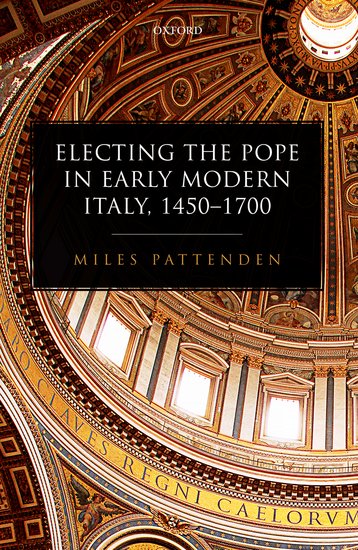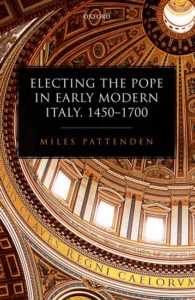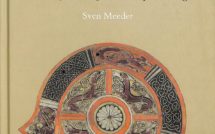
 In his new book, Electing the Pope in Early Modern Italy, 1450-1700, Miles Pattenden argues that the unique character of the papal electoral model contributed to the papacy’s increasing economic and structural problems throughout the early modern period. On one level, Pattenden is contributing to the debates about papal government that extend from Paolo Prodi’s seminal work, The Papal Prince (1987). On a broader level, however, he is one of a growing number of early modern historians interested in the development of institutional processes. In this regard, his work sits alongside Filippo de Vivo’s Information and Communication in Venice (2007), Rupali Mishra’s A Business of State (2018), an analysis of the East India Company, and Bill Bulman’s ongoing research on “divisions” in the House of Commons.
In his new book, Electing the Pope in Early Modern Italy, 1450-1700, Miles Pattenden argues that the unique character of the papal electoral model contributed to the papacy’s increasing economic and structural problems throughout the early modern period. On one level, Pattenden is contributing to the debates about papal government that extend from Paolo Prodi’s seminal work, The Papal Prince (1987). On a broader level, however, he is one of a growing number of early modern historians interested in the development of institutional processes. In this regard, his work sits alongside Filippo de Vivo’s Information and Communication in Venice (2007), Rupali Mishra’s A Business of State (2018), an analysis of the East India Company, and Bill Bulman’s ongoing research on “divisions” in the House of Commons.
The chapters are organized thematically, each offering a diachronic examination of the continuities and changes that papal elections and papal government underwent between 1417 and 1700. Several themes emerge as significant. Pattenden argues that by the early modern period, the cardinals constituted an oligarchic political class subject to the influence of various outside forces, including their families, the threat of Protestantism, and the interests of Catholic princes. Questions had lingered throughout the Middle Ages about whether the cardinals’ ability to elect a Pope implied some authority independent of the pontiff. Did they constitute a sort of Church Senate? Pattenden explains that the 1417 resolution of the Great Schism – during which three men claimed to be the true Pope – effectively made papal elections even more important. The compromises put in place to restore order in the Church were accommodated by a reduction in cardinals’ ability to oppose the Pope after election. In the context of the Protestant reformation, debates about whether priority should be placed on preserving church unity or insisting on doctrinal purity also influenced elections. Pattenden suggests that it was the concern for unity that won out, explaining that in the electoral reforms of 1621-2, Gregory XV formalized a veto power for Catholic princes – anyone who would be Pope needed to be acceptable to the rest of Catholic Europe.
One of the strongest elements of this volume is Pattenden’s assessment of how cardinals went about determining an acceptable candidate for the papal office. In chapter 5, he analyzes the “knowledge economy” that extended within and outside of the conclave, and the inherent tensions and informational chokepoints that resulted from attempts to cut the cardinal-electors off from outside interests. To develop an effective strategy for electing an acceptable candidate, cardinals needed information: details about various candidates’ visions for the papacy and about what other cardinals were thinking. But these were not the only consumers of this information. Foreign ambassadors, who were not always acquainted with the various papabili, needed to know what kind of men the candidates were in order to exert influence over proceedings. Roman bookies were also keen for news, offering them an advantage in the robust betting market about the duration and result of the conclave. In this chapter, the granularity of detail that Pattenden offers serves to bolster his analysis. For one interested in the mechanics of these kinds of political procedures, this chapter is deeply satisfying.
However, this tendency to offer a wealth of fascinating detail can serve as a double-edged sword in the exposition of Pattenden’s larger argument, which is at its most digestible when he is explicitly charting change over time. This is well-illustrated in his discussion of the methods of papal election. In the early Church, the Pope was selected under the principle of unanimitas. In the twelfth century, a requisite 2/3rds majority for papal election was introduced. Later, a policy developed allowing cardinals to “accede” to a candidate who emerged from early votes as a viable contender (either by writing down the names of all acceptable candidates on a ballot or by a subsequent show of hands). By the early modern period, it was not uncommon for the leaders of various conclave factions to agree upon a mutually acceptable candidate before the rest of the cardinals would indicate their approval by bowing to the new Pope-elect (per adorazione). The reforms of Gregory XV insisted on restoring the voting system to one vote per cardinal; abolished election by adoration; and mandated anonymity in the voting process. This outline is clearest in the final section of chapter 3. Even specialists may find that very deliberate reading is necessary to make sense of the mass of exceptional detail Pattenden offers in the rest of the chapter. He deploys fantastic specifics about how logistical matters for a conclave were (mis)managed: from the construction of sleeping cubicles for the cardinals in the Sistine Chapel, to the often thwarted attempts to ensure that information should not pass between the conclave and the outside world. However, it can sometimes be unclear what the reader is meant to take from this detail.
One of the outcomes of the Gregorian reforms was that conclaves, and their attendant periods of interregnum, became longer. When combined with the elective nature of the papacy, Pattenden argues that this phenomenon contributed to problems in conceptualizing the relationship between the authority of the Pope, as an office, and the authority of the Church more broadly. The cardinals attempted to emphasize the notion that the Pope’s authority did not die with him. Nevertheless, the death of a Pope would usually initiate a period of “misrule” (a term with which Pattenden is not entirely comfortable), in which the Roman populace might loot the dead Pope’s belongings. The power-vacuum that resulted from a papal death offered the Roman nobility and the communal magistrates the opportunity to wrestle authority from the College. To mitigate this problem, the cardinals tried to make alliances with these groups by offering them official roles to play (in the Pope’s funeral, in maintaining law and order, etc.) during the sede vacante.
Once a new Pope had been elected, Pattenden explains, he had much to do to assert his authority. He offers an interesting argument about the dual, elective-absolutist, nature of the papacy. Despite the Pope’s absolutist pretensions, the pontiff had to engage in a form of negotiation with his subordinates in order to rule effectively. Complicating the Pope’s attempts to govern with his oligarchic collaborators were the consequences of the papacy’s elective model. First, the Pope was likely not reared for leadership in the way that the heir-apparent of a hereditary monarchy might have been. Second, the elective model caused a reigning Pope to lose authority over time as the line of succession was unclear. In order to manage these challenges, early modern Popes relied on various methods of “visualizing authority” (188), including the papal coronation and the possesso (the procession during which the Pope took possession of the Lateran Basilica).
Pattenden also examines how patronage and nepotism were used to try to strengthen a new Pope’s political position. Yet, these strategies had unintended consequences and formed part of what Pattenden characterizes as a highly dysfunctional constitutional form. “By the seventeenth century,” he claims, “officials had successfully subverted the papacy’s absolutist character by constraining a Pope’s every action with wider considerations.” (220). Pattenden suggests that the erosion of papal freedom was a result of some of the very techniques that papal officials had developed to preserve their status within the curia. While the growth of bureaucracy offered cardinals and their families’ opportunity, the growth of offices diluted the effectiveness of any one position. While the buying and selling of offices (venality) offered the Pope short-term revenue, it also imposed long-term fiscal obligations. When criticism of venality reached a high-point, the papacy resorted to selling public debt – a development that would leave the institution in a deepening crisis as the seventeenth century progressed.
If it seems like curial officials were rooting for the papacy to fail, Pattenden is quick to observe throughout this work that this was a result of inherent tensions in the early modern papacy’s constitutional form. Some cardinals perhaps willed individual men to fail as Pope, but not the papacy to fail as an institution. Nevertheless, as Pattenden eloquently observes, by the dawn of the eighteenth century, the institution had been significantly weakened by these deeply ingrained institutional problems.
This book is an important contribution to scholarship on the early modern papacy. It has been richly researched and demonstrates a clear mastery of the field. While the reader has to do a significant amount of work to keep the strands of argumentation clear in some early chapters, the volume’s overarching argument comes together with satisfying elegance in the book’s second half (chapters 5-8).
Reviewed by Christopher P. Gillett, University of Scranton
Electing the Pope in Early Modern Italy, 1450-1700
By Miles Pattenden
Publisher: Oxford University Press
Hardcover / 384 pages / 2017
ISBN: 9780198797449
To read more book reviews click here
Published on December 11, 2018.




